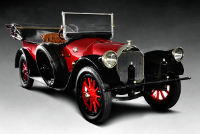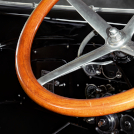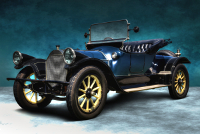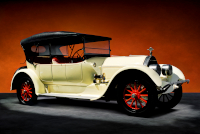Location:
RM Sotheby's, Hershey, 2017
Prologue:
My trip to Hershey in 2017 revolved around the Silver Arrow. Also on hand, this lovely Pierce-Arrow Touring. Tight quarters in the RM Sotheby's lot makes a decent perspective tricky, yet we worked out alright. All impressions hinted that this Model 38 would be a sound car, and in the short time I stopped for photos a few others popped 'round to inspect in earnest. Straightforward. Very handsome. One could do worse for nickel era touring car.
- - - - - - - - - -
► Image Source: Nikon D750 (24.3 MP)
References:
- Ralston, Marc. "Pierce-Arrow" A.S. Barnes & Co., Inc., San Diego, CA. 1980, page 87-88, 97, 231
- Ralston, Marc. "Pierce-Arrow, The Golden Age" Jostens Publications, Clarksville, TE. 1984, page 118
- RM Sotheby's: RM provides the brief history from which our information was taken.
The 'C4' designation marks this Pierce-Arrow as the fourth iteration of the restructured 38, 48, and 66 models at Pierce-Arrow. This model year represents the high point for the all-aluminum cast body, which, combined with bespoke engineering produced both in-house and through leading American industries, creates what is arguably the most dependable, durable, and best-driving touring car on the market. The price of entry is naturally unobtainable, and in the most casual on-road judgment, the aesthetics won't stray from the straight, conservative stance depicted in this five-passenger touring car.
While the original owners of this Pierce-Arrow are presently unknown, those records that have been retained place the car in Rhode Island in the early classic era, "when it was owned by two brothers who used it for automotive service calls and errands." This would seem at first too pedestrian for a Pierce-Arrow, but it's rather a testament to the car's construction that about 15, or maybe even 19 years after it was built—whence the automotive industry had progressed by leaps and bounds—this car is still worth driving on a daily basis. Most other antique era cars would have been derelict by the 1930s, if not dilapidated. But such is Pierce-Arrow's reputation that cars of then-obsolete design would be purchased by fire departments and other working interests. Two decades later, these cars ran well and refused to fall apart. This service-oriented role would be the point at which this car, chassis #36793, came to be known.
From World War II until the early 1970s this car stayed hidden away, still residing in Rhode Island. Two successive owners came to its aid over the next two decades; the second, Manny Souza, completed the car's first and only restoration over a period of six years in the late 1980s. That restoration endures today. And having seen the car in the flesh, the condition appears sympathetically clean, with clear paint, underpinnings, and interior. The car is very impressive—of big stature—and a strong statement in firehouse red.
Less ostentatious than many contemporary luxury cars, the Model 38 really is equal to the sum of its parts, acknowledging that each of those parts is designed and built to a standard that is nearly impossible to replicate today. Of its contemporaries, perhaps the Rolls-Royce Silver Ghost embodied this principle best, while outdoing the competition in terms of luxury. Hispano-Suiza pushed the envelope, and by the time war called upon industry to shift its focus, did so perhaps to a standard no one else could match—even Rolls. In Germany, Mercedes-Benz were quickly putting luster on the silver star with similar accolades. And at home in America, Packard were close on Pierce's heels with the Twin Six, an early V-12 luxury car that would influence no less than Enzo Ferrari. And yet none of these other cars, for all their refinement and performance, were built with such an audacious plan, insisting on a cold-riveted, all-aluminum cast body, fitted with motors tested for flawless travel that, even from the 1900s, was measured in thousands of miles. In other words, it looks like a simple old car, but it is quite special.
Motor: 6,795 cc (414 cubic inch) straight 6-cylinder | 101.6 mm x 139.7 mm (4" x 5½")
Valvetrain: T-head, dual-valve, dual ignition
Aspiration: single updraft carburetor
Power: 38 rated horsepower @ 2,000 rpm
Drivetrain: 4-speed manual transmission, rear-wheel drive
Front Suspension: drop-forged I-beam axle, special heat-treated steel, with semi-elliptic leaf springs and Westinghouse air springs
Rear Suspension: live axle with three-quarter-elliptic leaf springs
Architecture: steel channel-section frame, cast aluminum body
Kerb Weight: 1,950.4 kg (4,300 lbs)
Wheelbase: 3,403.6 mm (134 inches)
Etymology:
The Model 38 takes its designation from the rated horsepower (not actual) of its 6-cylinder motor. The '-4' designation identifies the car as part of Pierce-Arrow's Series 4 production, which began with Series 1 in 1913 with the Model 38-C. (None of the 1913 Series 1 cars uses a '-1' to indicate the series.) The 'C' simply refers to the least of three models, the Model 38-C, Model 48-B, and Model 66-A. In retrospect, Pierce-Arrow needn't have used any letter designation at all. As for the series designation, where the first two series roughly spanned a year each, Series 3 production began in 1914 and ran through 1916. Series 4 production began in December 1915 and continued through August 1918, itself constituting two separate production runs.
Figures:
In 1916, Pierce-Arrow produced 2,004 Series 4 Model 38-C automobiles.
Value:
This car sold at the 2017 RM Sotheby's auctions in Hershey, Pennsylvania for $154,000.
Straight and True: Aluminum Coachwork at the Height of Pierce-Arrow Production
An early Pierce-Arrow—particularly an aluminum-bodied car—is very much the sum of its meticulously developed parts. There is not anything outwardly pretentious about a Pierce-Arrow Touring of this era, other than its size, perhaps, that would call the casual onlooker's attention. There are the Dawley-designed headlamps—a concession to greater dispersion of light and safety—which of course one can quickly use to identify the car. But otherwise, most of the value is stocked in the mechanical components, the cost-no-object engineering, and the groundbreaking cast aluminum coachwork that would not be replicated by anyone henceforth. If this sounds like hyperbole, it's only to impress that an otherwise simple looking antique car can be something rather remarkable if one looks just beneath its paint.
Handsomely Updated: Comments on Condition
With a restoration nearly 30 years old, this Pierce-Arrow still looked regal when seen in person. (Or as they say in the business, it presents well.) The tonneau cover is particularly nice, with its fitment around the front seats, and the running gear and suspension components are clean and tidy. The car's size is also a factor in its strong presence—with a longer wheelbase than a contemporary Packard Twin Six, though this is an entry-level Pierce-Arrow. The overall shape and stance is comparable to some rare Locomobiles I have seen, though of course it retains those trademark Pierce-Arrow features. There are the headlamps, yes, and also the dash lights whose ubiquity was confirmed by the company's aluminum body casting—nearly all contemporary Pierce-Arrows use these small bulkhead lights because they mostly use the same casts. But otherwise this Model 38 bears few beatific advances beyond its scale and proportion.
Comfort Ride: Westinghouse Air Spring Suspension
The two tall canisters at the front guard are Westinghouse air springs. One Richard Liebau of New Haven, Connecticut designed the air spring and filed for US patent February 26, 1919. So the addition to this Model 38-C-4 would of course be after-market. According to the patent, "This invention relates to air springs for vehicles and the object is to provide a spring whereby the load platform is supported [relative] to the running gear by means of a vacuum and pressure." The springs are vacuum charged and may be adjusted using an air valve; they press on a piston that moves inside a sealed, oil-filled chamber at the top of the device. In an era dominated by carriage springs and friction dampers, the coil spring and shock absorber are many decades from ubiquity. Liebau's Westinghouse spring is an early step toward a modern suspension, and would have seemed remarkable in 1919, an attachment that could cushion the weight of an entire car.
Last Updated: Mar 26, 2025








